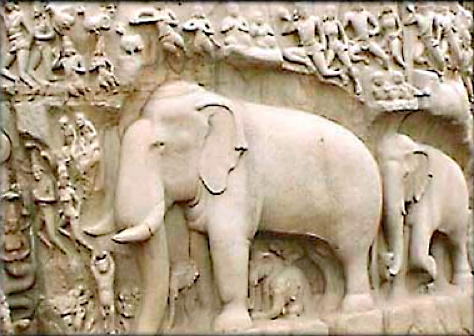History
 Tamil is taught at the University of Chicago since early1960s. Pedagogical materials were prepared at different times, which include materials for learning colloquial Tamil heard at homes and on streets, which differs considerably from the formal Tamil, heard in public speeches and read from newspapers and books. This difference has earned for Tamil the tag diglossic language and it introduces some challenges to the teaching of Tamil. One of the challenges is to integrate judiciously both varieties in the pedagogical materials and to build means of migrating from one to the other, when learning the appropriate contexts of using the two.
Tamil is taught at the University of Chicago since early1960s. Pedagogical materials were prepared at different times, which include materials for learning colloquial Tamil heard at homes and on streets, which differs considerably from the formal Tamil, heard in public speeches and read from newspapers and books. This difference has earned for Tamil the tag diglossic language and it introduces some challenges to the teaching of Tamil. One of the challenges is to integrate judiciously both varieties in the pedagogical materials and to build means of migrating from one to the other, when learning the appropriate contexts of using the two.
E. Annamalai prepared in 1966-69 at the University of Chicago graded conversations in Tamil, called Jim-Raja conversations, which have been used by successive Tamil instructors at this University and other Universities in the U.S. and abroad. James Lindholm added translations of the conversations and a formal version of the conversations in conventional spelling that is used for writing the formal Tamil. He got grammatical points linked to a grammatical description elsewhere. The print materials and audio recordings of them were distributed to learners by his Tamil Language Studies Association.
The conversations in colloquial Tamil were in the Roman script. This handicapped the learners in recognizing the conversations in Tamil script and had their Tamil pronunciation influenced by the phonetic value of the Roman letters they have in English. Further, the learners did not get to know the difference in the spelling of words in the two varieties of Tamil. The web course has the conversations rendered in Tamil script that was specially developed by E. Annamalai to write the colloquial Tamil. There was no convention of writing colloquial Tamil in Tamil script until the modern period. The spelling used in modern prose literature is not consistent between authors and it tends to be an approximated transcription of pronunciation rather than a spelling system.
New materials
 Tamil language use has changed in the past half a century and so has its pedagogy. The colloquial style is now written in Tamil fiction, jokes and such genres and consequently in the pedagogical materials. This spelling system differs from the conventional spelling system used for writing formal Tamil, but it is relatable to it by a set of rules of pronunciation. Some spelling differences, however, need to be learned as unpredictable differences between the two varieties.
Tamil language use has changed in the past half a century and so has its pedagogy. The colloquial style is now written in Tamil fiction, jokes and such genres and consequently in the pedagogical materials. This spelling system differs from the conventional spelling system used for writing formal Tamil, but it is relatable to it by a set of rules of pronunciation. Some spelling differences, however, need to be learned as unpredictable differences between the two varieties.
The objective of the course on the web is to make available in digital form conversational materials for speaking to First Year Tamil students and to provide comparable descriptive materials for reading at this level. The former are called Conversations and the latter Basic Texts.
Rewritten Jim-Raja conversations reflects the changes in the Tamil society and in the language that have taken place in the last few decades. Glossary has been added to the conversations. A large number of exercises to practice grammatical structures have been added. Since dictionary reference is only with the conventional (i.e. formal) spelling of words and since the conversations are presented in Tamil script, it is necessary to teach the alphabet and the spelling system of the colloquial Tamil as part of teaching conversations in addition to teaching reading of formal Tamil. The materials for teaching both are presented under Alphabet.
Audio materials
The digitized Tamil materials are provided in audio records also for the conversations, texts and alphabet mentioned above. The audio materials are synchronized with their print (visual) form. Grammatical exercises and cultural notes do not have yet their audio counterpart. This course of learning materials will be made into multimedia materials subsequently. A grammar book of colloquial Tamil also will be added subsequently. Until then, learning Tamil using this course will be facilitated by having an instructor or tutor.
Conditions of Use
The intellectual copyright of all the materials will rest with E. Annamalai. The users of these materials other than the students of this University will be governed by Creative Commons BY-NC-ND License. This license prohibits distribution of derivative works and any commercial use.
Credit
The project to digitize and upload the materials was supported by a grant from the Language Consortium, University of Chicago; guidance on the project was given by Jim Nye and Michael Berger; technical support was provided by Rodney Edward, Eli Thorkelson and Peter Thorson; designing and entering the materials on to the web was done by Harini Jaganathan; voice was given by Constantine Nakssis and Nageswari Annamalai
This Tamil Course is dedicated to James Lindholm, who loves languages and among them, Tamil is closest to his heart.
Guidelines for using these materials
See also: A Note for self-learners
These pedagogicl materials should cover the basic needs of teaching Tamil for roughly 200 hours. The materials are intended to meet the needs of two years of instruction in the Universities, which are named variably as Introductory and Intemediate, Beginner level and Middle level etc. The materials may be divided up differently depending on the division of the academic year into quarters or semesters. The materials are intended to teach both the colloquial or spoken variety and the formal or written variery of Tamil. It is assumed in the materials that these are two styles of Tamil, which at their extreme ends may be nearly incomprehensible. The materials, however, are written in a style that is in the middle, where the two varieties are quite compatible. Thus the two sets of materials, one for each variety, may be treated for the pedagogical purpose as the same language following different spelling systems. Instructors who teach both varieties forllow different methods of combining them: teaching them in parallel from the beginning; starting with one in the beginning and introducing the other at some later point, making the one the primary with more time allocation and the other secondary with less time etc. These materials assume the teaching of both varieties but give more time to the colloquial in the first hundred hours and less time to the formal (75:25) and reverse this ratio in the second hundred hours. Nevertheless, they could be used in the classroom in various other combinations as well.
The two sections on the alphabet are to enable learning of the alphabet and the pronunication of letters and words in both varieties. Jim-Raja conversations are in colloquial Tamil transcribed in a pedagogically standardized spelling system. The same conversations are made available in the conventional spelling also for comparison as well as for using just the formal variety in the classroom. There are ten additional conversations in the colloquial variety marked for grammatical structures or communicative situations. There are ten elementary texts beased on the content of Jim-Raja conversations to be used for introducing the formal variety keeping the content of the narratives familar to the students from the Conversations. There are five tales to supplement for teaching the formal variety with explanations of differences in vocabulary and in grammar (basically morphology) between the two varieties. The pattern of correspondence between the spelling of the two varieties (from colloquial to formal) is given in the section Grammar Aid. Basic Reader is for teaching the formal variety with twenty texts of social commentaries, mythological stories, folk tales and literary passsages retold.
Jim-Raja Conversations as well as Basic Reader have exercises for practice. Both have glossary at the end of each unit. As regards grammatical points, the exercises in Jim-Raja Conversations hint at the grammatical information requried to do the exercises; the texts are followed by selective grammatical explanation in Basic Reader. There is a section, Grammatical Aid. that gives collective information for various grammatical structures. The section, Vocabulary Aid, is meant to develop skills in the use of words and combination of words as well as to familiarize the meanings of words, especially the semantic classes of words. The Handouts after the Exercises in Jim-Raja Conversations are for using as reference materials by the learners. Sandhi rules regarding doubling of stop consonants across words are given for writing formal Tamil; though they apply for the most part to colloquial Tamil as also, the doubled stop consonant is not indicated in its spelling.
There is an English translation of Jim-Raja Conversations, which is meant for checking when questions of comprehension arise, and not as a pedagogical tool in teaching the language.
The materials must be augmented with mutli-media materials drawn from other sources and with real life exposure through trips to places to use the Tamil learned in the classroom.
